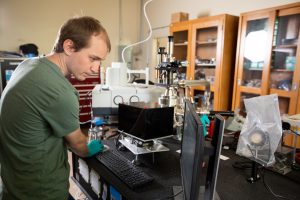Student spotlight
Asteroid miner in training: Student researcher studies micrometeorite weathering
 Mitchell Magnuson has otherworldly aspirations. The senior Physics and Astronomy major dreams of someday working to develop tools that can be used to mine asteroids. In preparation, he’s doing research here at NAU with associate professor Mark Loeffler in the PEAXS (Processes, Environments, and Astrochemistry on Extraterrestrial Surfaces) Research Laboratory to understand how space weathering affects asteroids.
Mitchell Magnuson has otherworldly aspirations. The senior Physics and Astronomy major dreams of someday working to develop tools that can be used to mine asteroids. In preparation, he’s doing research here at NAU with associate professor Mark Loeffler in the PEAXS (Processes, Environments, and Astrochemistry on Extraterrestrial Surfaces) Research Laboratory to understand how space weathering affects asteroids.
On Earth, the actions of wind and water erode and change the landscape. In space, there are different forces at work, including solar wind, cosmic rays, and fast-moving dust particles known as micrometeorites.
Since going to space to do their research isn’t a practical option, the research team has to bring space to their lab.
“What we’re doing is just simulating, as best we can, in a laboratory environment,” Magnuson said.
The researchers have chosen to study the most common type of asteroid, known as C-type—which make up more than 75 percent of known asteroids—to understand how they are affected by micrometeorites. In the lab, minerals such as San Carlos olivine stand in for the asteroid. They grind San Carlos olivine crystals into a fine powder and press the powder into a pellet.
“We then take a graphite rod and slice a piece off of it so we have a graphite disk. These two pieces, the graphite and the olivine, are then placed in the vacuum chamber to simulate an airless environment, like the surface of an asteroid in space,” Magnuson explained.
“A high-energy laser pulse then rasters across the surface of the graphite. When the laser pulse impacts the surface of the graphite, material is ejected and re-deposited on the olivine. After the experiment is done, we take the olivine out of the chamber and measure it with near-infrared and ultraviolet spectroscopy to see how the surface has changed. We look to see whether the olivine has gotten darker, whether its spectral slope has changed, and we examine the overall shape of the spectra. Then we put the olivine back in the chamber and start all over again.”
Magnuson said it takes about two days to prepare the vacuum chamber and the experiment itself takes a couple of hours. He said in a good week he can complete three experiments.
He compares the data with data astronomers have gathered using telescopes. This information will help astronomers and others developing space missions aimed for asteroids to have a better idea of the surface composition of these asteroids. Furthermore, how these weathered surfaces differ from the pristine under-layer of these asteroids helps to address the broader question of how airless bodies in our solar system are evolving and can better constrain conditions under which they may have formed.
“When scientists send a satellite out to an asteroid, such as the Hayabusa2 mission to Ryugu or OSIRIS-Rex to Bennu, samples will be collected and returned back to Earth,” he said. “These samples will be analyzed and compared to what the experimental data predicted so that we can further refine how these bodies in space are weathered and correct our assumptions as needed.”
“Carbonaceous asteroids like the ones we’re studying are roughly 4 billion years old, the same age as the solar system. By determining how these surfaces have evolved over time, we can come to understand what has happened in the solar system since its formation. Was there a period of higher solar flux which contributed to a certain type of surface alteration on these asteroids? Was there a moment in time where there were a lot more micrometeorites floating around the solar system and impacting asteroid bodies and planets alike? By researching space weathering in a lab and coupling it with space missions to these asteroids, we can probe the evolution of the solar system.”
The sky is not the limit
Magnuson will graduate in the spring. He’s applying to graduate schools to study aerospace engineering. After that?
“My ultimate goal is to mine asteroids. It’s what I’ve always wanted to do.”
If he reaches his goal, he’ll be a pioneer.
“No one has mined an asteroid yet, but there are many theories as to how to go about it. You have to go to it. You can get these gigantic electromagnets and rake up ferrous material, iron, off the surface. You can heat it to break up the volatile compounds, basically hydrate minerals, and then release that into hydrogen oxygen to use as rocket fuel.”
Magnuson’s work here at NAU is taking him a step closer to his goal.
“Astronomy at NAU is awesome,” he said. “The faculty here are amazing, they’re world experts. You just can’t get that sort of experience elsewhere. And there’s a lot of opportunity for undergrads to do research so you aren’t just in the classroom. Coming to NAU was the greatest decision I’ve made in my life.”
His mentor, Leoffler, said working with students like Magnuson is part of the reason he’s at NAU.
“I came to NAU because it is great place to build a research program where students can actively participate. Mitch has done a great job in his research and I am happy to have contributed to his success here at NAU,” Leoffler said.
